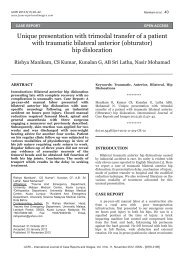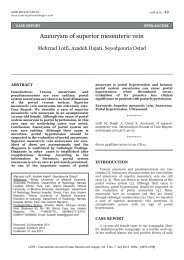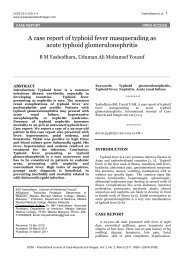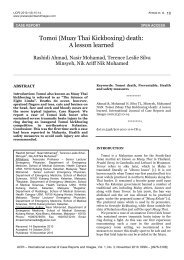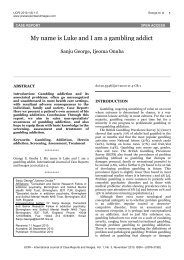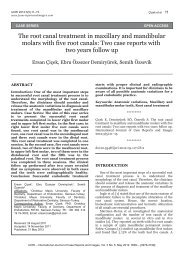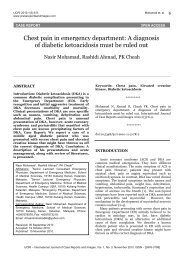Provisional PDF - International Journal of Case Reports and Images ...
Provisional PDF - International Journal of Case Reports and Images ...
Provisional PDF - International Journal of Case Reports and Images ...
You also want an ePaper? Increase the reach of your titles
YUMPU automatically turns print PDFs into web optimized ePapers that Google loves.
IJCRI 201 2;():****.<br />
www.ijcasereports<strong>and</strong>images.com<br />
Roy et al. 4<br />
choledochal cyst or associate congenital hepatic fibrosis<br />
in patients with caroli`s disease [4, 79].<br />
Choledochal cyst complicated by portal hypertension<br />
should be differentiated from portal biliopathy. Portal<br />
biliopathy, a recent terminology, has been used to<br />
describe changes in the bile duct due to cavernous<br />
transformation in patients with portal hypertension.<br />
Such changes are more common in patients with<br />
extrahepatic portal vein occlusion. These biliary<br />
abnormalities are classified as varicoid, fibrotic or<br />
mixed. In the varicoid type there is irregular contour <strong>of</strong><br />
the bile duct as a result <strong>of</strong> multiple smooth extrinsic<br />
compression <strong>of</strong> the cavernoma clearly seen in MRCP or<br />
magnetic resonance angiography. In the fibrotic type<br />
magnetic resonance scans show localized strictures with<br />
proximal dilatation [11].<br />
The various case reports <strong>and</strong> case series previously<br />
documented in literature are summarized in table 1.<br />
Gillis et al. reported two cases <strong>of</strong> choledochal cyst<br />
with portal hypertension in which<br />
choledochojejunostomy was performed with regression<br />
<strong>of</strong> features <strong>of</strong> portal hypertension at 10 months follow<br />
up in one case <strong>and</strong> three years in the second case [8].<br />
Martin et al. reported three cases <strong>of</strong> choledochal cyst<br />
with portal hypertension managed by them in which<br />
choledochojejunostomy was done in two cases with<br />
regression <strong>of</strong> symptoms <strong>of</strong> portal hypertension at three<br />
years follow up in one case <strong>and</strong> four years in the other.<br />
In the third case surgery was refused by the parents <strong>and</strong><br />
the patient died [8].<br />
Fonkalsrud et al. reported a case in which a<br />
choledochal cyst was missed on initial evaluation <strong>and</strong> a<br />
splenorenal shunt was done. Subsequently the expected<br />
fall in portal pressure did not occur <strong>and</strong> on further<br />
exploration <strong>of</strong> abdomen a choledochal cyst was found<br />
<strong>and</strong> a choledochojejunostomy was performed with an<br />
immediate fall in portal pressure. At one year follow up<br />
there was a complete regression <strong>of</strong> esophageal varices<br />
[8]. The case emphasized that a shunt procedure for<br />
portal decompression in complicated choledochal cyst<br />
with portal hypertension will not lead to regression <strong>of</strong><br />
portal hypertension <strong>and</strong> only excision <strong>of</strong> cyst will cure<br />
the portal hypertension.<br />
Rao et al. presented a review <strong>of</strong> four cases <strong>of</strong><br />
choledochal cyst with portal hypertension managed by<br />
them. In the first case cyst excision with isolated jejunal<br />
loop interposition hepaticoduodenostomy was done<br />
with gradual regression <strong>of</strong> esophageal varices <strong>and</strong><br />
congestive gastropathy at three months follow up. In the<br />
second case RouxenY cystojejunostomy was done with<br />
regression <strong>of</strong> esophageal varices at three months follow<br />
up. In the third case there were extensive collaterals<br />
around the porta <strong>and</strong> splenectomy with a vascular shunt<br />
between inferior mesenteric vein <strong>and</strong> renal vein was<br />
done but the patient died while waiting for a definitive<br />
surgery due to fatal episode <strong>of</strong> hemetemesis. In the<br />
fourth case RouxenY hepaticojejunostomy was done<br />
with complete resolution <strong>of</strong> varices at six months follow<br />
up [4].<br />
Saluja et al. repoted three cases <strong>of</strong> choledochal cyst<br />
with portal hypertension managed by them. In the first<br />
case RouxenY hepaticojejunostomy was done <strong>and</strong><br />
patient was well at one year follow up. The second case<br />
was associated with alcoholic liver disease with Child<br />
Class C cirrhosis <strong>and</strong> the patient died <strong>of</strong> liver failure. In<br />
the third case the patient initially underwent an ERCP<br />
with stenting followed by a repeat ERCP with removal <strong>of</strong><br />
multiple stones after lithotripsy. Three months later<br />
patient developed cholangitis with renal failure <strong>and</strong> the<br />
patient died nine months after the diagnosis [9]. Singh<br />
et al. reported a case <strong>of</strong> choledochal cyst with portal<br />
hypertension managed by them in which RouxenY<br />
hepaticojejunostomy was done [7].<br />
In a retrospective study <strong>of</strong> 144 patients with<br />
choledochal cysts managed between January 1989 <strong>and</strong><br />
June 2004 at a tertiary level referral hospital in North<br />
India, six patients had portal hypertension. Cyst<br />
excision was performed successfully in three out <strong>of</strong> six<br />
patients. In two patients an internal drainage was<br />
resorted to because <strong>of</strong> excessive bleeding from the<br />
collaterals in the hepatoduodenal ligament. One patient<br />
did not report for definitive surgery after a percutaneous<br />
biliary drainage for recurrent severe cholangitis [10].<br />
It is evident from the review <strong>of</strong> literature that<br />
treatment <strong>of</strong> choledochal cysts complicated by portal<br />
hypertension has evolved from internal drainage <strong>of</strong> cysts<br />
to single stage excision <strong>of</strong> cyst with bilioenteric<br />
anastomosis. Endoscopic drainage may be considered as<br />
a temporary measure in patients who are unfit for<br />
surgery. In the presence <strong>of</strong> hypervascularity <strong>of</strong> the<br />
hepatoduodenal ligament <strong>and</strong> pericholedochal varices<br />
an attempt for cyst excision should be made rather than<br />
a shunt procedure for portal decompression as a shunt<br />
will not cure the portal hypertension <strong>and</strong> a second stage<br />
surgery for the excision <strong>of</strong> choledochal cyst will still be<br />
required. However, in the presence <strong>of</strong> extensive<br />
collaterals in the hepatoduodenal ligament, which is<br />
more commonly seen in associated portal vein<br />
thrombosis, portal decompression in the form <strong>of</strong> portosystemic<br />
shunt should be done first followed by cyst<br />
excision 612 weeks later [6, 7, 10]. It should be kept in<br />
mind that in patients with Child Class C status a shunt<br />
may deteriorate liver function by diverting the portal<br />
blood flow <strong>and</strong> hence liver transplantation should be<br />
<strong>of</strong>fered to such patients.<br />
ACCEPTED MANUSCRIPT<br />
PROVISIONAL <strong>PDF</strong><br />
CONCLUSION<br />
In conclusion, treatment <strong>of</strong> complicated choledochal<br />
cyst has evolved over the years from internal drainage to<br />
single stage excision. Single stage excision <strong>of</strong> cyst with<br />
bilioenteric anastomosis is the treatment <strong>of</strong> choice for<br />
choledochal cyst with portal hypertension. In cases<br />
where complete excision <strong>of</strong> cyst is not possible, partial<br />
excision <strong>of</strong> cyst with stripping <strong>of</strong> mucosa can be done. As<br />
in our case regression <strong>of</strong> varices without any evidence <strong>of</strong><br />
recurrence is a pointer for preference towards single<br />
stage procedure.<br />
*********<br />
IJCRI – <strong>International</strong> <strong>Journal</strong> <strong>of</strong> <strong>Case</strong> <strong>Reports</strong> <strong>and</strong> <strong>Images</strong>, Vol. No. , 201 2. ISSN – [0976-31 98]



